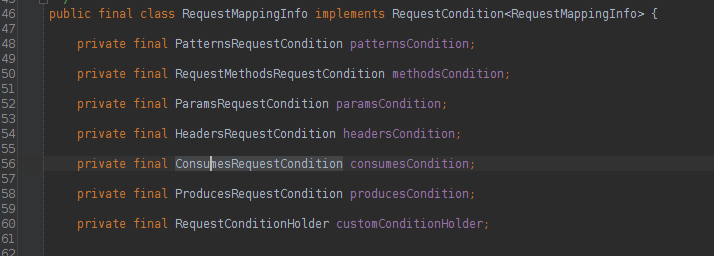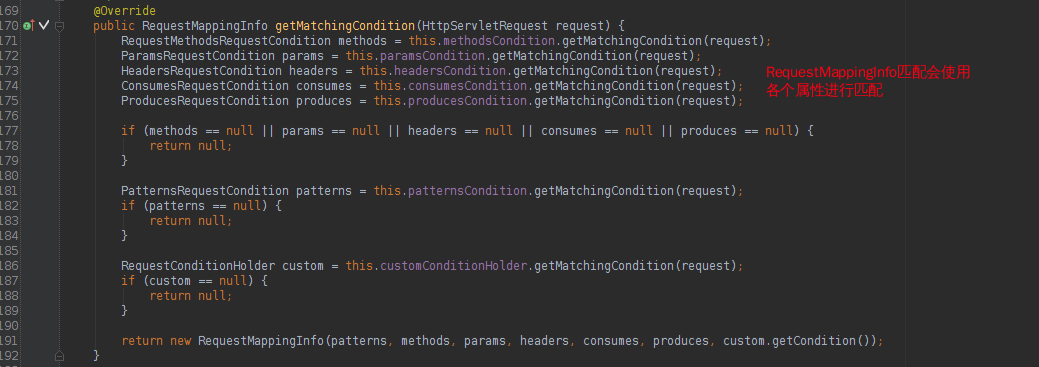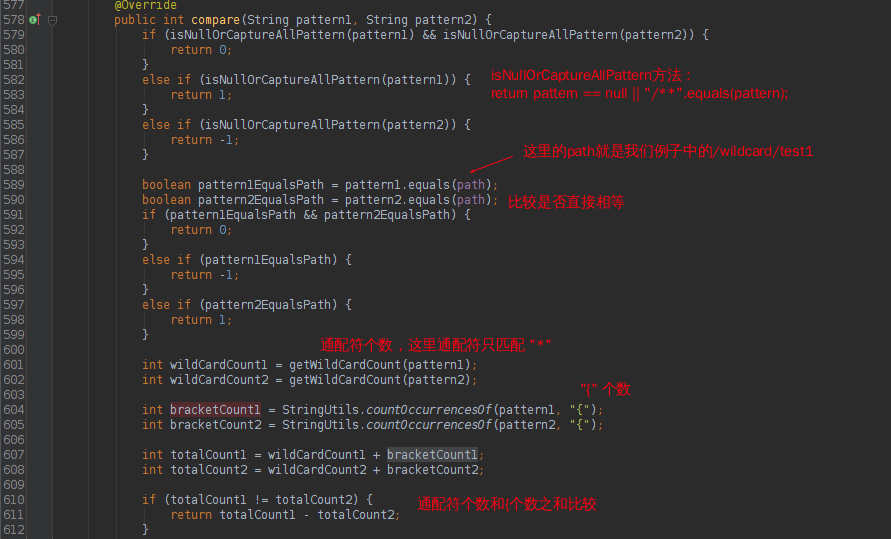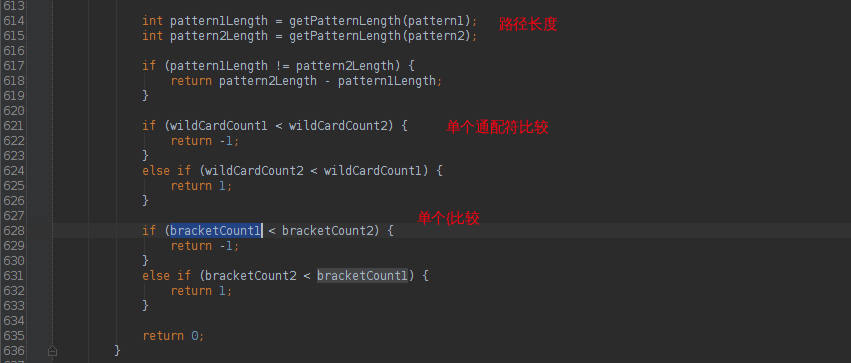SpringMVC是目前主流的Web MVC框架之一。
我们使用浏览器通过地址 http://ip:port/contextPath/path进行访问,SpringMVC是如何得知用户到底是访问哪个Controller中的方法,这期间到底发生了什么。
本文将分析SpringMVC是如何处理请求与Controller之间的映射关系的,让读者知道这个过程中到底发生了什么事情。
本文实际上是在上文基础上,深入分析
HandlerMapping里的
HandlerExecutionChain getHandler(HttpServletRequest var1) throws Exception;
该方法的具体实现,包括它如何找到对应的方法,以及如何把结果保存在map里,以便让请求转发到对应的handler上,同时也分析了handleradaptor具体做了什么事情。
源码分析
在分析源码之前,我们先了解一下几个东西。
1.这个过程中重要的接口和类。
HandlerMethod类:
Spring3.1版本之后引入的。 是一个封装了方法参数、方法注解,方法返回值等众多元素的类。

它的子类InvocableHandlerMethod有两个重要的属性WebDataBinderFactory和HandlerMethodArgumentResolverComposite, 很明显是对请求进行处理的。
InvocableHandlerMethod的子类ServletInvocableHandlerMethod有个重要的属性HandlerMethodReturnValueHandlerComposite,很明显是对响应进行处理的。
ServletInvocableHandlerMethod这个类在HandlerAdapter对每个请求处理过程中,都会实例化一个出来(上面提到的属性由HandlerAdapter进行设置),分别对请求和返回进行处理。 (RequestMappingHandlerAdapter源码,实例化ServletInvocableHandlerMethod的时候分别set了上面提到的重要属性)

MethodParameter类:
HandlerMethod类中的parameters属性类型,是一个MethodParameter数组。MethodParameter是一个封装了方法参数具体信息的工具类,包括参数的的索引位置,类型,注解,参数名等信息。
HandlerMethod在实例化的时候,构造函数中会初始化这个数组,这时只初始化了部分数据,在HandlerAdapter对请求处理过程中会完善其他属性,之后交予合适的HandlerMethodArgumentResolver接口处理。
以类DeptController为例:
@Controller
@RequestMapping(value = "/dept")
public class DeptController {
@Autowired
private IDeptService deptService;
@RequestMapping("/update")
@ResponseBody
public String update(Dept dept) {
deptService.saveOrUpdate(dept);
return "success";
}
}
(刚初始化时的数据)

(HandlerAdapter处理后的数据)

RequestCondition接口:
Spring3.1版本之后引入的。 是SpringMVC的映射基础中的请求条件,可以进行combine, compareTo,getMatchingCondition操作。这个接口是映射匹配的关键接口,其中getMatchingCondition方法关乎是否能找到合适的映射。

RequestMappingInfo类:
Spring3.1版本之后引入的。 是一个封装了各种请求映射条件并实现了RequestCondition接口的类。
有各种RequestCondition实现类属性,patternsCondition,methodsCondition,paramsCondition,headersCondition,consumesCondition以及producesCondition,这个请求条件看属性名也了解,分别代表http请求的路径模式、方法、参数、头部等信息。

RequestMappingHandlerMapping类:
处理请求与HandlerMethod映射关系的一个类。
2.Web服务器启动的时候,SpringMVC到底做了什么。
先看AbstractHandlerMethodMapping的initHandlerMethods方法中。



我们进入createRequestMappingInfo方法看下是如何构造RequestMappingInfo对象的。

PatternsRequestCondition构造函数:

类对应的RequestMappingInfo存在的话,跟方法对应的RequestMappingInfo进行combine操作。

然后使用符合条件的method来注册各种HandlerMethod。

下面我们来看下各种RequestCondition接口的实现类的combine操作。
PatternsRequestCondition:


RequestMethodsRequestCondition:
方法的请求条件,用个set直接add即可。

其他相关的RequestConditon实现类读者可自行查看源码。
最终,RequestMappingHandlerMapping中两个比较重要的属性
private final Map<T, HandlerMethod> handlerMethods = new LinkedHashMap<T, HandlerMethod>();
private final MultiValueMap<String, T> urlMap = new LinkedMultiValueMap<String, T>();
T为RequestMappingInfo。
构造完成。
我们知道,SpringMVC的分发器DispatcherServlet会根据浏览器的请求地址获得HandlerExecutionChain。
这个过程我们看是如何实现的。
首先看HandlerMethod的获得(直接看关键代码了):

这里的比较器是使用RequestMappingInfo的compareTo方法(RequestCondition接口定义的)。

然后构造HandlerExecutionChain加上拦截器

实例
写了这么多,来点例子让我们验证一下吧。
@Controller
@RequestMapping(value = "/wildcard")
public class TestWildcardController {
@RequestMapping("/test/**")
@ResponseBody
public String test1(ModelAndView view) {
view.setViewName("/test/test");
view.addObject("attr", "TestWildcardController -> /test/**");
return view;
}
@RequestMapping("/test/*")
@ResponseBody
public String test2(ModelAndView view) {
view.setViewName("/test/test");
view.addObject("attr", "TestWildcardController -> /test*");
return view;
}
@RequestMapping("test?")
@ResponseBody
public String test3(ModelAndView view) {
view.setViewName("/test/test");
view.addObject("attr", "TestWildcardController -> test?");
return view;
}
@RequestMapping("test/*")
@ResponseBody
public String test4(ModelAndView view) {
view.setViewName("/test/test");
view.addObject("attr", "TestWildcardController -> test/*");
return view;
}
}
由于这里的每个pattern都带了*因此,都不会加入到urlMap中,但是handlerMethods还是有的。

会先根据 “/wildcard/test1” 找urlMap对应的RequestMappingInfo集合,找不到的话取handlerMethods集合中所有的key集合(也就是RequestMappingInfo集合)。
然后进行匹配,匹配根据RequestCondition的getMatchingCondition方法。

最终匹配到2个RequestMappingInfo:

然后会使用比较器进行排序。
之前也分析过,比较器是有优先级的。
我们看到,RequestMappingInfo除了pattern,其他属性都是一样的。
我们看下PatternsRequestCondition比较的逻辑:


因此,/test*的通配符比/test?的多,因此,最终选择了/test?

直接比较优先于通配符。

@Controller
@RequestMapping(value = "/priority")
public class TestPriorityController {
@RequestMapping(method = RequestMethod.GET)
@ResponseBody
public String test1(ModelAndView view) {
view.setViewName("/test/test");
view.addObject("attr", "其他condition相同,带有method属性的优先级高");
return view;
}
@RequestMapping()
@ResponseBody
public String test2(ModelAndView view) {
view.setViewName("/test/test");
view.addObject("attr", "其他condition相同,不带method属性的优先级高");
return view;
}
}
这里例子,其他requestCondition都一样,只有RequestMethodCondition不一样。

看出,方法多的优先级越多。

至于其他的RequestCondition,大家自行查看源码吧。
资源文件映射
以上分析均是基于Controller方法的映射(RequestMappingHandlerMapping)。
SpringMVC中还有静态文件的映射,SimpleUrlHandlerMapping。
DispatcherServlet找对应的HandlerExecutionChain的时候会遍历属性handlerMappings,这个一个实现了HandlerMapping接口的集合。
由于我们在*-dispatcher.xml中加入了以下配置:
<mvc:resources location="/static/" mapping="/static/**"/>
Spring解析配置文件会使用ResourcesBeanDefinitionParser进行解析的时候,会实例化出SimpleUrlHandlerMapping。


其中注册的HandlerMethod为ResourceHttpRequestHandler。


地址匹配到/static/**。
最终SimpleUrlHandlerMapping找到对应的Handler -> ResourceHttpRequestHandler。
ResourceHttpRequestHandler进行handleRequest的时候,直接输出资源文件的文本内容。
总结
大致上整理了一下SpringMVC对请求的处理,包括其中比较关键的类和接口,希望对读者有帮助。
让自己对SpringMVC有了更深入的认识,也为之后分析数据绑定,拦截器、HandlerAdapter等打下基础。

 随时随地看视频
随时随地看视频



